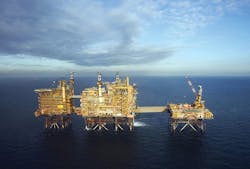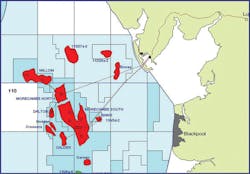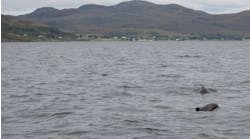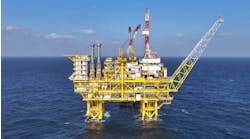Efficiency measures, platform overhauls prolong field life
Jeremy Beckman
Editor, Europe
The South Morecambe bridge-linked platform complex. (Images courtesy Spirit Energy)
Since 1985, the Morecambe Bay fields in the East Irish Sea have provided a steady supply of gas, at one point accounting for 15% of the UK’s needs. Over the years the original developer British Gas expanded the offshore production and onshore processing facilities to accommodate tie-ins from other fields in the area. Subsequent operators Centrica and now Spirit Energy have continued that program.
When the fields were discovered in 1974, the original resources were over 700 tcf; now an estimated 300 bcf remains. Recently Spirit Energy initiated decommissioning, announcing plans to shut down two of the field’s unmanned drilling platforms and to recover a wellhead protection structure from the depleted Bains subsea satellite. But other platforms are undergoing refurbishment as the company looks to extend production from the area into the 2020s.
Offshore spoke to Tamsin Lishman, Morecambe Bay Director at Spirit Energy, about the current program and prospects for the years ahead.
Offshore:Where are the Morecambe Bay platforms and how extensive is the drilling and production complex?
Lishman: The Morecambe Bay gas fields are 26 km [16 mi] west of Blackpool on the northwest coast of England, in water depths of around 20 m [65 ft]. The South Morecambe main installation comprises three, bridge-linked platforms weighing a combined 58,000 metric tons [63,934 tons]. It includes an accommodation block, a processing and export block, and a drilling platform. The seven normally-unmanned installations (North Morecambe, DP3, DP4, DP8, DP6, Calder and Millom West) weigh between 5,000 and 8,000 metric tons [5,511 and 8,818 tons], and are each equipped as drilling platforms.
Offshore: What was the originally envisaged lifespan of the facilities, and what are their current conditions?
Lishman: The predicted lifespan was 25 years when the South Morecambe field came online in 1985, with North Morecambe following in 1994. DP6 has recently undergone a nine-month maintenance and simplification (barge-supported) campaign, which should extend its life by a further 10-15 years. DP3 and DP4 are nearing the end of their lives, as the gas reserves the installations previously tapped into are now produced by other unmanned platforms nearby. We are moving towards plugging and abandoning the wells on DP3 and DP4, with topside and jacket removal to follow later.
Offshore: What changes were needed to tie in production from other accumulations in the area?
Lishman: The only field in the hub with sour gas – hydrogen sulfide (H2S) – is Calder. The Calder topside is fully equipped to receive sour gas, as are the export pipeline and associated onshore processing facilities. The North Morecambe platform was modified to enable the tie in of the Millom East/ West and Dalton fields, and more recently the addition of Rhyl, where the gas features high levels of carbon-dioxide [CO2], with some nitrogen [N2], although no chemical mitigation measures were required offshore. However, an eductor was installed to ensure the North Morecambe field was not backed out by the new higher pressure Rhyl field, which came onstream in 2013. The wells at North Morecambe are now controlled remotely from the North Morecambe Terminal control room.
Offshore: Are the export pipelines in good shape?
Lishman: Yes, the 37-km [23-mi] subsea pipeline from North Morecambe to the Barrow Gas Terminals is in good condition and is pigged regularly. There is also a pipeline from the South Morecambe platform to the Barrow Gas Terminals, with a new 1.1-km [0.68-mi] onshore underground section now routing incoming gas from the South Morecambe Terminal to North. There is also a pipeline from the Calder field to the Rivers part of the Barrow Gas Terminals, where hydrogen sulfide [H2S] is stripped out before entering the North Morecambe Terminal process.
Location of the Morecambe Bay gas fields in the East Irish Sea.
Offshore: Did Centrica explore for other fields in the area, because the Rhyl manifold was designed for tie-ins of potential future discoveries?
Lishman: We have explored across the entire East Irish Sea basin. The Rhyl manifold was designed for additional Rhyl wells or for tying back any further discoveries in the northern part of the basin. While Spirit has no immediate plans to explore for or develop other fields on our acreage in the basin, we welcome third-party opportunities and are “open for business” to provide transportation and processing services. We do have capacity to receive more gas from any new discoveries or developments in the area.
Offshore: Has management and planning of the Morecambe Bay offshore/onshore facilities changed under Spirit Energy’s direction?
Lishman:The team overseeing the Morecambe Bay area remains the same following the transition from Centrica to Spirit Energy – projects which were initiated while we were part of Centrica continue, and we are now looking at new ways to introduce technology and work with our partners to extend the fields further. For maintenance, we use CAN, NSG and WorleyParsons.
Offshore: How are the ConocoPhillips-operated Rivers fields, developed previously by Burlington Resources, connected to the infrastructure?
Lishman: Those fields are produced via normally-unmanned installations. All except Calder are connected to the North Morecambe platform via subsea pipelines and controlled remotely via the North Morecambe Terminal – Calder is produced via a dedicated pipeline to the Rivers terminal.
Offshore: What are the onshore processing capabilities?
Lishman: The North Morecambe Terminal came online in 1994 and was designed to process gas from the North Morecambe field at peak production, and so has more than enough capacity to handle the gas processing requirements from both North and South Morecambe, as well as the relevant ConocoPhillips fields. Next to the North Morecambe Terminal is the Rivers Terminal, which is set up to process the sour gas from the Calder field. It is owned by ConocoPhillips, and Spirit Energy operates the terminal on their behalf. Last year, Barrow Borough Council approved plans to demolish the South Morecambe Terminal, and these operations will be performed later this year and into early 2019.
Offshore: The North Morecambe terminal uses the ‘Drying Beads’ technique to strip liquids from incoming gas. How does this work, and why is it needed?
Lishman: Gas specifications for export into the UK’s national transmission system, and thus the domestic supply, required the gas to be dewpointed so that liquids are not formed within the pipelines. As gas cools components condense and become a liquid, therefore dewpointing the gas is used to remove the components that are most likely to condense at certain temperatures and pressures. South Morecambe Terminal’s method for dewpointing was to use a refrigerant to condensate the water and heavy hydrocarbons, however the refrigerant used was a CFC, now considered environmentally unfriendly.
The North Morecambe Terminal however employs a different technique for dewpointing the gas that involves use of silica beads to absorb the water/methanol and the heavier hydrocarbons. Once the beads are saturated, they are regenerated using hot gas (i.e. driving the liquids from the bead, allowing it to be re-used).
Offshore: Last July, Centrica announced plans to boost production by developing previously untapped reservoirs at North Morecambe, with associated modifications on the North Morecambe platform. What was the outcome?
Lishman: The new equipment was an eductor, which was installed during a planned maintenance shutdown. We are already seeing the benefits, as we have since been able to maximize production from existing reservoirs. An eductor is a device that uses a high-pressure stream to boost a low-pressure stream: in this case, it redirects some of Rhyl’s higher pressure to increase flow from the North Morecambe wellstreams, allowing us to extract an extra 8.8 bcf of gas.
Offshore: Can you provide details of another, ongoing £60-million [$85-million] investment to overhaul equipment on certain platforms?
Lishman: Sparrows won the contract to remove the 27-year old cranes on our DP6 and eight normally unmanned platforms and then transfer them onshore for full refurbishment, followed by re-installation offshore. Other obsolete equipment will be removed from DP6, with Servelec supplying new distributed control, emergency shutdown, fire and gas and smoke detection systems. In addition, the lifeboats will undergo refurbishment.
Offshore: Realistically, how long can you see the Morecambe Bay fields producing at commercially viable rates? Is gas storage a longer-term option?
Lishman: We are planning for the Morecambe Bay fields to continue production into the 2020s and the investments we’ve made and are making today help us get to that point – but the fields are among the most mature on the UK continental shelf. Regarding gas storage, the Morecambe fields are not suitable for storage operations due to the geology in the area.





